Last Updated: 12 months ago
Are there cat breeds with round ears?
You may have seen photos circulating on social media and thought you could get one of these cuties.
But do they really exist? Find out below, plus learn all you need to know about other cat breeds with unique ears.
Cats with Round Ears Explained
Sorry to burst your bubble, but truly domestic cats with round ears don’t exist.
Most of the cat breeds we have, both wild and domestic, have pointed ears, and that’s actually a good thing.
Rounded ears are more common in larger cats such as leopards and lions (I will explain this in a moment).
The pictures you’ve seen circulating on the internet result from photo editing using an app known as Cymera.
Cymera is a Japanese app that helps users edit their photos, add filters, and apply other special effects.
One of the effects that became an instant hit was the mousy ears that made cats, dogs, and even bunnies look like Mickey Mouse.
But there’s no cat breed with such ears yet. But with selective breeding, maybe this could be possible in the future.
The Science Behind It
Smaller cats having more pointed ears didn’t happen by chance. It’s an adaptation to their environment.
According to an article published in the DayDayNews, rounded ears may help capture almost all the sounds from the front, but they may fail to capture sounds from the rear of the cat.
On the other hand, pointed ears are excellent at capturing sounds from all directions.
Now, big cats capture large prey such as gazelles and zebras. This is prey they can easily spot, so they don’t need their ears to hunt.
But smaller cats hunt small prey, so they need all their senses to hunt effectively.
Small cats are also prey to some larger predators, so having heightened hearing capabilities comes in handy.
That explains the difference in the shape of the ears.
Cats With Bent Ears
While cat breeds with round ears don’t exist, there are cats with unique ears that you might want to check out.
These are cats whose ears are slightly bent forward or backward, and it’s often a result of a genetic mutation. Below are some examples of these cat breeds:
#1 American Curl

American Curls are some of the most popular breeds of cats with unique ears.
Their ears curl backward as a result of a dominant genetic mutation. That means that as long as one parent has the gene, some of the kittens will have curled ears.
All American Curls have straight ears at birth. But the folding starts appearing after a few days and stops when they’re four months old.
So, where did this cat breed originate from? American Curls are native to the United States, specifically California. The first American Curl was a stray cat named Shulamith.
The Rugas, a Suburban family living in Lakewood, California, took her in in 1981. After some time, she gave birth to 4 kittens, and 2 of these kittens had unique ears.
Selective breeding began immediately, and by 1986, the America Curl cat breed was recognized by the Cat Fanciers Association, and they were registering cats with the same physical characteristics and genetic make-up.
By 1992, they were participating in cat shows and had even achieved champion status.
Today, several cat owners find American Curls suitable pets thanks to their excellent disposition. They are friendly, affectionate, and sometimes playful.
They are also pretty healthy, and the mutation doesn’t affect any other part of the body like in the Scottish Folds (more on this later).
However, you need to be careful with the ears since they are sensitive due to the curling.
#2 Scottish Fold
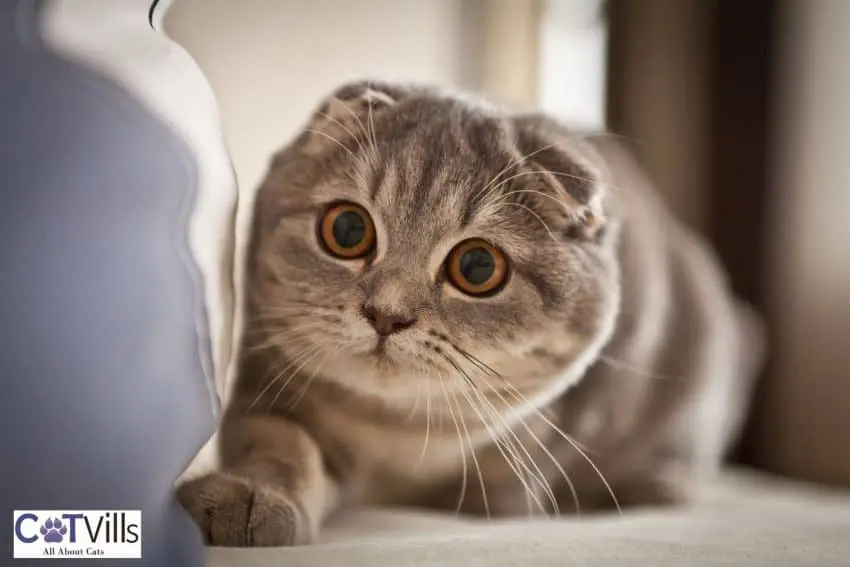
This is another cat breed with bent ears. But instead of folding backward like in the American Curls, they fold forward, giving them an owl-like appearance.
Scottish Folds originated in Perthshire, Scotland, and the first Scottish Fold was known as Susie.
Selective breeding of the Scottish Folds was initiated in 1961 by William Ross, a cat Fancier who acquired one of the kittens from Susie’s litter.
The spontaneous mutation responsible for this characteristic affects the ear’s cartilage, causing it to fold. It can be a single fold, double, or triple fold.
Unfortunately, this mutation also affects cartilage and bone development throughout the cat’s body.
That’s why Scottish Folds are more susceptible to Arthritis and painful joint degenerative diseases.
This also explains why most cat registries were hesitant to register this breed, and the breeding of this cat is also banned in various parts of the world.
Nevertheless, their calm temperament, affection, and overall disposition make them some of the most sought-after kittens.
Celebrities such as Taylor Swift and Ed Sheeran own these cats too. Since the ears fold forward, they end up accumulating dirt faster, so check them and clean them often.
#3 Highlander Shorthair
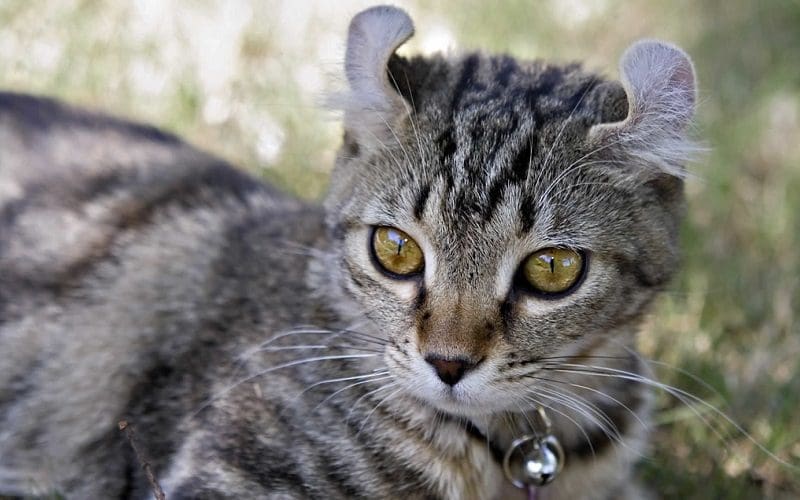
The Highlander Shorthair is a relatively new cat breed that was introduced in 2004.
It was not developed from any of the old cat breeds we have today.
Instead, breeders used experimental cat breeds such as the Desert Lynx and the Jungle Curls.
They got the curled ears from the Jungle Curls. Highlanders also feature a bobbed tail and a well-built, muscular body.
Highlanders make good companions due to their playful nature, but they aren’t very loud or talkative like Siamese cats.
Unlike the Scottish Folds, the curled ears aren’t accompanied by any defects. Highlanders are a healthy cat breed.
Read more about the highland lynx price.
Other Cats with Curled Ears
More cat breeds have this characteristic through crossbreeding of various cat breeds with cats with naturally occurring bent ears.
Below are some of the cats with curled ears.
- Elf Cat: A crossbreed between a Sphynx cat and an American Curl. The result is a hairless cat with big ears that curl backward. If you’ve watched Harry Potter, then the Elf Cat is an almost replica of Dobby.
- Folder/Exotic Folds: Crossbreed between Exotic Shorthairs and Scottish Folds.
- Ukrainian Levkoy: Crossbreed between a Donskoy cat and a Scottish Fold.
Cats with Big Ears
Cats are generally small, with small ears, tiny paws, and compact builds, and we love them for that. But those with big ears tend to be more attractive to some.
They are also the closest you can get to cats with round ears. Since, as I mentioned earlier, the editing app makes the ears look larger and rounded. Below are some cat breeds with large ears.
Abyssinian

Abyssinian cats are known for large ears with sharp tips. Their large ears may explain why they have an always-alert look.
They are quite energetic and good companions for people who enjoy playing with their cats and teaching them new tricks.
The Abyssinian cat is believed to have come from Abyssinia (modern-day Ethiopia), but today’s modern breed was developed in Great Britain.
Devon Rex
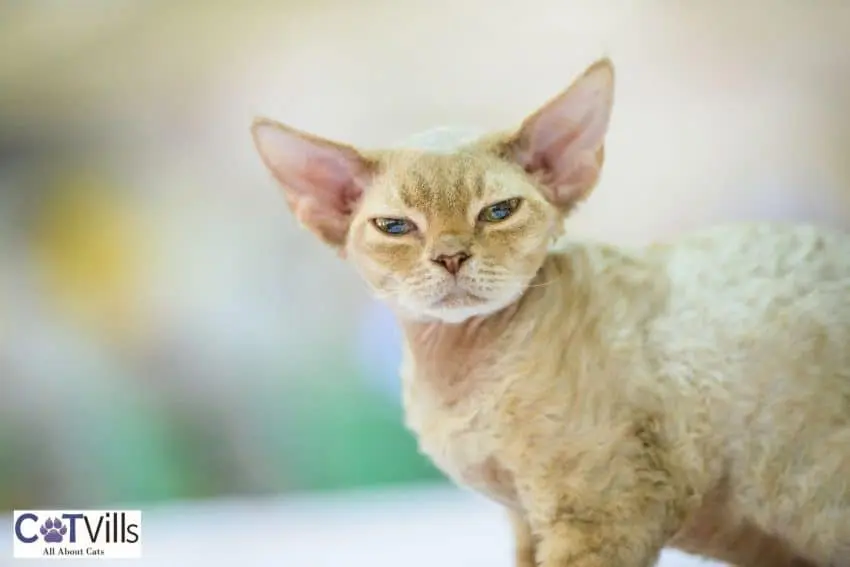
The Devon Rex is a relatively small cat with big ears. They are characterized by a short curly coat, slender build, and large, oval-shaped eyes that sometimes give them a mischievous look, and they can be mischievous.
Devon Rexes are highly intelligent and trainable, but can also be quite stubborn. They first appeared in 1959 in the United Kingdom.
And even though they are similar to the Cornish Rexes, curly hair is caused by an entirely different mutation.
The Governing Council of the Cat Fanciers (GCCF) recognized this Cat Breed in 1967, and they were first introduced in the USA in 1968.
By 1983, they received championship status by the Cat Fanciers Association.
Siamese
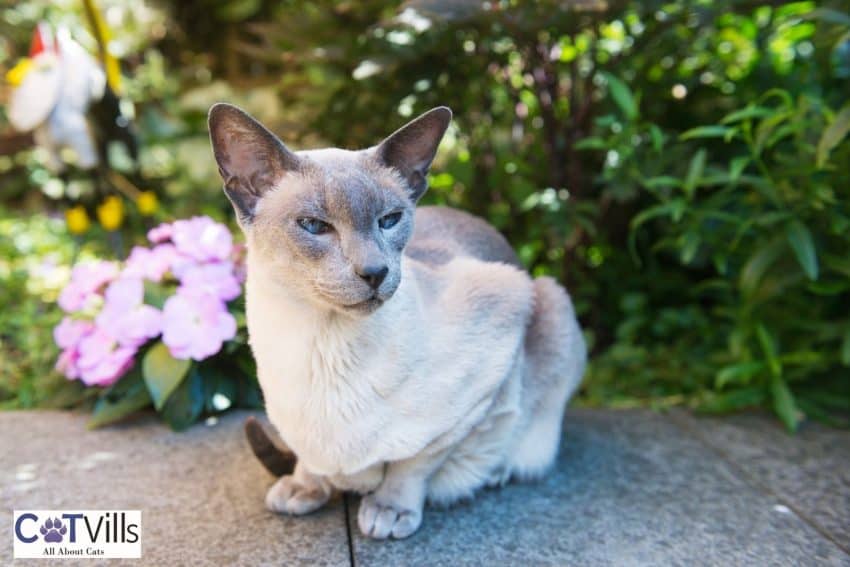
Known for being some of the chattiest pets, the Siamese is another cat breed with large ears. They often have a sliver-grey coat, but other color variations are also available.
They also have dark-colored points on their ears, paws, and tail, a triangular head, and blue eyes.
What you might not know is that they have an albinism gene that affects their coat color.
But this modifying gene relies on temperatures. The temperatures have to be higher than 100 degrees F for albinism to kick in.
When temperatures are lower than 100 degrees F, the coat gains its respective color.
Ears, nose, and paws are often cold, which explains the pointed-color pattern.
It’s not clear where they came from, but History places them in Thailand, though selective breeding has been involved in developing the modern Siamese cat.
Other Cat Breeds With Large Ears
- Balinese
- Cornish Rex
- Javanese
- Sphynx
- Oriental
- Chausie
- Savannah
Cat Breeds with Short Ears
Now that we know the cat breeds with big ears, it’s only fair to mention cat with small ears.
- Highlanders
- American Curls
- Birman
- Exotic Shorthair
- British Shorthair
- Persian
- Scottish Fold
Cats with Ear Tufts and Furnishings
Other unique features that occur on the cat’s ears are the tufts and furnishings.
Ear tufts are the hair that grows along the ears, and they help prevent debris buildup in the ears.
Ear tufts are also known to improve hearing in most predators, such as the Lynx. However, not all cat breeds exhibit these features.
Furnishings grow in the ears, and they also improve the animal’s hearing ability. Below are some cat breeds with these features:
- LaPerm
- Maine Coons
- Highlanders
- American Curls
- Nebelung
- Ragdoll
- Norwegian Forest Cats
FAQs
CAN CATS HAVE ROUND EARS?
Yes, but mostly big cats such as leopards and lions. Smaller cats, including domesticated ones, often have pointed or triangular ears, which are relatively more effective for all-directional hearing.
This is to help them hunt for small animals. It also helps them protect themselves from predators attacking from behind.
WHICH CAT BREEDS HAVE LARGE EARS?
Some cat breeds with big ears include the Siamese, Abyssinian, Devon Rex, Oriental, Sphynx, Javanese, Cornish Rex, and Balinese.
WHY ARE SCOTTISH FOLD CATS BANNED?
Breeding Scottish Folds is banned in some regions since they develop painful joint degenerative diseases, deformities, and other immobility issues.
Conclusion
As much as we would love to have cats with round ears, they don’t exist.
As I’ve established, small cats need pointed or triangular-shaped ears to make them better at hunting and sensing predators.
But if you’d love to seed those rounded ears on your cat, you could use a photo editing app such as Cymera.
What do you think of cats with round ears? Do you think that’s going to be cute? Please share your thoughts!
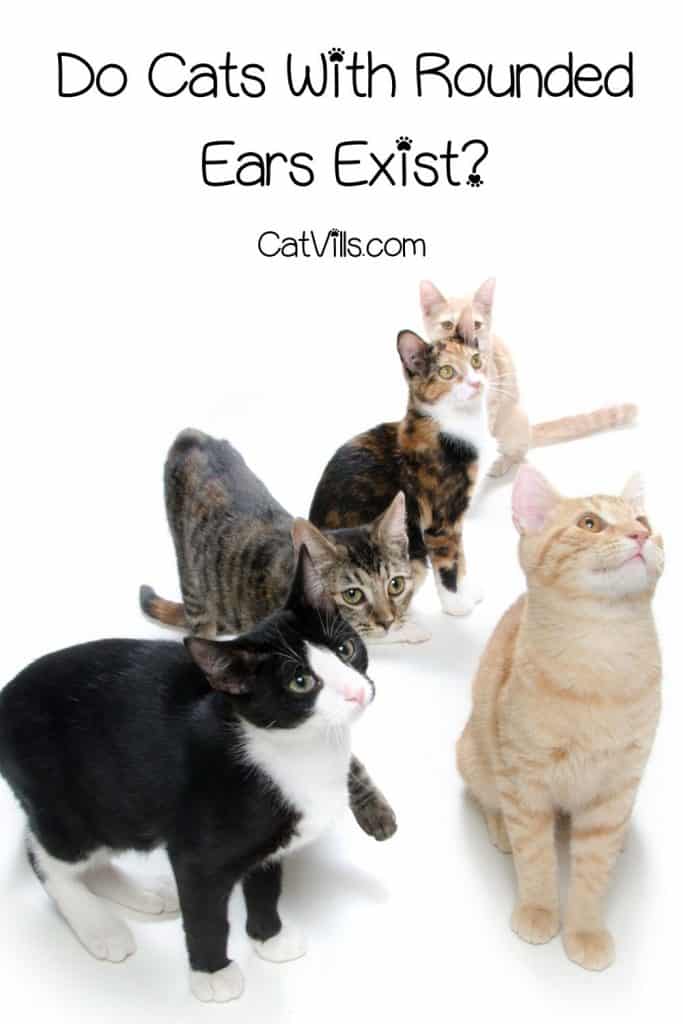

I really never noticed the ears on a cat. The round ears are very cute.
These cats are unique. I’ve never seen anything like them and it’s interesting that you can breed them. I’d love a cat with round ears int he house
Ha, that’s an interesting question. I never thought of that before. I haven’t seen one with rounded ears.
The round-eared cats are cute, but I think I prefer the classic pointy-eared version 🙂
Fascinating! I had never heard of cats with rounded ears until this article.
I have to admit I never noticed there was so many different ear types! How cute.
I never know that cat has round ears. It’s so cute. Thanks for sharing this!
I am so glad that cats with round ears don’t exist. They are to strange.
I didn’t know there is such breed. That is so cool to know!
Wow, I learned something new today. I didn’t know that there are cat breeds with rounded ears.
Wow, I didn’t know that there are cat breeds that has rounded ears! I wish to see one in the future!
I only learned about Scottish Folds recently. It is good to know that the other breed does not deal with health issues as a result.
I admit I never noticed they were so many different types of ears! Great to know though
This is my first time learning about the app. I will share this with my friend who loves cats too.
I am so glad that cats with round ears do not exist…. As I think it is a bit weird looking LOL. I love my kitty and his beautiful pointy ears…. And always love stopping y to read the latest and greatest animal post from you 😉